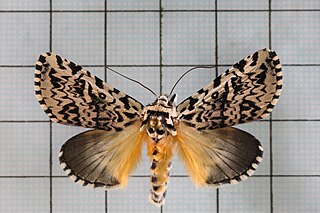The dark-brown serotine is a species of vesper bat found in Central and West Africa.

Deltote deceptoria, the pretty marbled, is a moth of the family Noctuidae. The species was first described by Giovanni Antonio Scopoli in his 1763 Entomologia Carniolica. It is found in southern and central Europe.

Lithacodia uncula, the silver hook, is a moth of the family Noctuidae. The species was first described by Carl Alexander Clerck in 1759. It is found in the Palearctic realm.
Koyaga is a genus of moths of the family Noctuidae. The genus was described by Ueda in 1984.

Deltote is a genus of moths of the family Noctuidae. The genus was described by Reichenbach in 1817.

Lithacodia is a genus of moths of the family Noctuidae.
Pseudodeltote is a genus of moths of the family Noctuidae.

Trichosea champa is a moth of the family Noctuidae first described by Frederic Moore in 1879. It is found in the Himalayas, north-east India, Sri Lanka, China, Taiwan, Japan, and Russia.

Diarsia brunnea, the purple clay, is a moth of the family Noctuidae. The species was first described by Michael Denis and Ignaz Schiffermüller in 1775. It is found in most of Europe, east to Transcaucasia, the Caucasus, central Asia, Siberia, the Kuriles, Amur, Ussuri, Sakhalin, Korea, Japan, and China, including China’s Tibet region.

Koyaga virescens is a moth of the family Noctuidae first described by Shigero Sugi in 1958. It is found in Japan and Taiwan.

Pseudodeltote formosana is a species of moth of the family Noctuidae first described by George Hampson in 1910. It is found in Taiwan. The length of the forewings is 12–14 mm.

Pseudodeltote coenia is a species of moth of the family Noctuidae first described by Charles Swinhoe in 1901. It is found in Taiwan.
Protodeltote wiscotti is a species of moth of the family Noctuidae first described by Otto Staudinger in 1888. It is found in the Russian Far East and Japan.
Protodeltote distinguenda is a species of moth of the family Noctuidae first described by Otto Staudinger in 1888. It is found in Korea, Taiwan and Japan.
Protodeltote inexpectata is a species of moth of the family Noctuidae first described by Ueda in 1984. It is found in Japan.
Micardia argentata is a species of moth of the family Noctuidae first described by Arthur Gardiner Butler in 1878. It is found in China, Korea and Japan.
Koyaga falsa is a species of moth of the family Noctuidae first described by Arthur Gardiner Butler in 1885. It is found in China, Korea and Japan.
Koyaga numisma is a species of moth of the family Noctuidae first described by Otto Staudinger in 1888. It is found in Russia, China, Korea and Japan.
Koyaga senex is a species of moth of the family Noctuidae first described by Arthur Gardiner Butler in 1881. It is found in Japan.







